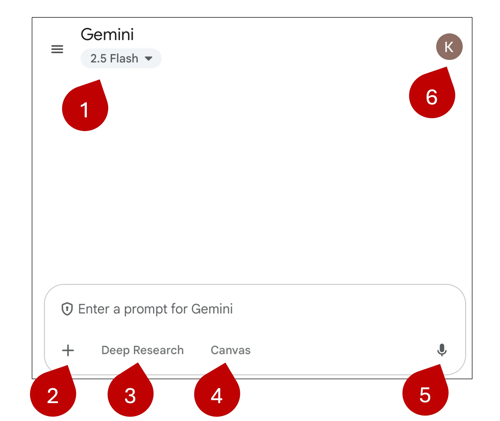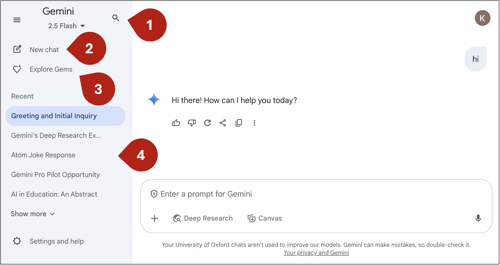Google Gemini Onboarding Guides | AI Competency Centre
Google Gemini Onboarding Guides
Welcome! This page contains instructions for signing in to Google Gemini. You will need to sign in to the Oxford Gemini Workspace using your Oxford SSO.
How to sign in to Gemini with you Oxford Single Sign On (SSO)
You can use your SSO email (abcd1234@ox.ac.uk) to sign in to Gemini. This will be sent to your SSO email address ending with `@ox.ac.uk`. It may land in your junk mail folder.
To sign in, follow these instructions:
- Open the gemini.google.com webpage.
- Click the Sign in button.
- Enter your Single Sign On (SSO) email address in the format `abcd1234@ox.ac.uk` and press Next. (*Please note that using a department alias such as `@it.ox.ac.uk` will not work*).
- You will be directed to the standard University SSO log-in process.
- Once logged in, click ‘Chat with Gemini’
Support and training
Congratulations! You have finished setting up your Google Gemini account!
You may move on to the next step of the onboarding process by clicking one of the following sections. For new users, we suggest starting with the first tab Getting started using Google Gemini where you can explore how to use Gemini.
This page is for users that have no experience or limited experience with Gemini. It covers basic information on the structure of the Gemini interface.
This powerful tool offers revolutionary support for work cases spanning administration, research, education, and beyond. Its chief limitation is user imagination. It is one of the jobs of the AI and Machine Learning Competency Centre to help new and experienced users alike explore these possibilities.
Fundamentally, Gemini works by a call-and-response kind of conversational interface. The user sends a request or statement to the AI (called a “prompt”) and then the AI responds to that prompt in a way that resembles a text message conversation.
Gemini Chat Interface
The main chat interface has several major parts. The most important is labelled “Enter a prompt for Gemini”. This is where you click to type in your message and “talk” to the AI.
The other five elements are labelled below:

- Switch which “model” you want to use. Think of the *model* as the particular AI brain that you want to talk to. They range in terms of abilities and intelligence. In the image below, you see the model “2.5 Flash” is selected. This is the default model useful for most tasks, and you can also choose “2.5 Pro” which is a more advanced model for tasks such as reasoning, maths, and code.
- Attach files. You can upload upload directly from your machine or pull them in from Google Drive.
- Deep Research. Deep Research in Gemini functions as an AI-powered research tool. It receives a user-defined prompt and then formulates a multi-step research plan. The system then autonomously browses and analyses online information, potentially across hundreds of websites. It processes the gathered data, reasons through findings, and synthesizes this information into structured, comprehensive reports.
- Canvas. Canvas in Gemini is an interactive workspace for document and code creation. It enables real-time collaboration with the Gemini AI. Key functions include generating and refining content drafts. For coding, it generates snippets (e.g., HTML, Python), provides live web app previews, and aids debugging. Content can be exported to Google Docs. It also integrates with Deep Research reports for import, editing, and transformation into formats like web pages or infographics.
- Microphone. The microphone function in Gemini allows for voice input and interaction. It enables users to speak their queries or commands directly to the AI.
- Account Information. Here you can click to find information about your account and sign out.
Gemini Extended Interface
Beyond the chat window, Gemini offers additional functionality across the platform.

- Search chat history. This function allows you to search through all of your past conversations at once, so that you can find all the conversations that relate to a specific topic. This can be super handy if you recall having a conversation about a certain topic, but you can't find it in your chat history.
- Start New chat. This button allows you to start a new conversation from scratch.
- Explore Gems. Gems are ready-to-go conversations with the AI that are already primed with context and background information. Once you initiate one of these custom Gems, you'll be able to hit the ground running to get useful responses from the AI that may have otherwise taken a while to elicit in a normal conversation window.
- Chat history. This section catalogues a list of your past conversations with the AI. ChatGPT will automatically name these conversations based on the content of what you have discussed with the AI. If you wish to rename them, hover over the name and then click the three dots which will reveal options to rename and archive that conversation.
Google has put together some resources and courses to introduce beginners to their tools. We recommend starting with the 'Getting started with Google AI in Higher Education' course which will help to explain what Google AI is and show practical ways it can support higher education practices.
For users who are already experienced with generative AI and want more advanced onboarding to Gemini, we have collected the following resources.
Next part of the onboarding
To continue your exploration and learning with like-minded individuals, we invite you to join the Generative AI Special Interest Group (SIG) hosted on Microsoft Teams.
This community is a collaborative space for educators, researchers, and professionals who are passionate about leveraging AI in education. As a SIG member, you’ll gain access to:
- Engaging Discussions: Join thought-provoking conversations and exchange insights with a diverse group of peers.
- Exclusive Resources: Explore curated materials, tips, and guides to maximize your use of Gemini in educational settings.
- Workshops & Events: Participate in regular webinars, live demos, and collaborative sessions to deepen your understanding and expand your skills.
- Expert Support: Benefit from direct access to AI Consultants from the AI and Machine Learning Competency Centre, who are available to support you in integrating and innovating with AI tools like Gemini.
We look forward to welcoming you to this dynamic community!
Having trouble with your Google Gemini or NotebookLM?
- Consider first seeking support from the company whose product you're using:
Google Gemini: Google's Gemini Apps Help page offers various pieces of advice and support for using Gemini.
NotebookLM: Google’s NotebookLM Help page covers help topics from getting started to troubleshooting NotebookLM.
If your query is about whether an outage is affecting your connection to a particular tool, try the relevant status pages:
- Google Status page for Google Gemini and NotebookLM - For simple queries regarding University-supported GenAI tools and support, use the AI Competency Centre chatbot to be directed to relevant information.
- For support accessing AI services, contact the Central IT Service Desk.
You are welcome to join Oxford’s AI community. Join the AI SIG (Special Interest Group) for broader AI discussions and connect with the BUG (Builders User Group) if you’re a builder. Become an AI Ambassador if you would like to assist with the implementation of AI at Oxford and share knowledge within your team.
💡 Special Interest Group (SIG)
Link: Generative AI SIG | General | Microsoft Teams
The SIG serves as the broad, University-wide community for exploring generative AI’s impact on teaching, research, and innovation. It’s ideal for:
- Discussing AI use in education and professional settings.
- Connecting with others across disciplines.
- Accessing updates, learning resources, and events.
🛠️ Builders User Group (BUG)
Link: AI-BUG - AI Builders User Group | General | Microsoft Teams
The BUG is specifically for developers, engineers, and AI builders interested in:
- Running local models, APIs, and custom bots.
- Sharing tools, frameworks, and open-source projects.
If you’re focused on development, experimentation, and implementation, the BUG is your dedicated space.
🤖 AI Ambassadors
Link: AI Ambassadors
The AI Ambassadors are active AI users from across the collegiate University who are happy to be points of contact for colleagues in their local context.
Ambassadors can:
- Signpost you to best practice guidance
- Offer advice on how to integrate AI into your work
- Help to mentor you in applying AI tools

